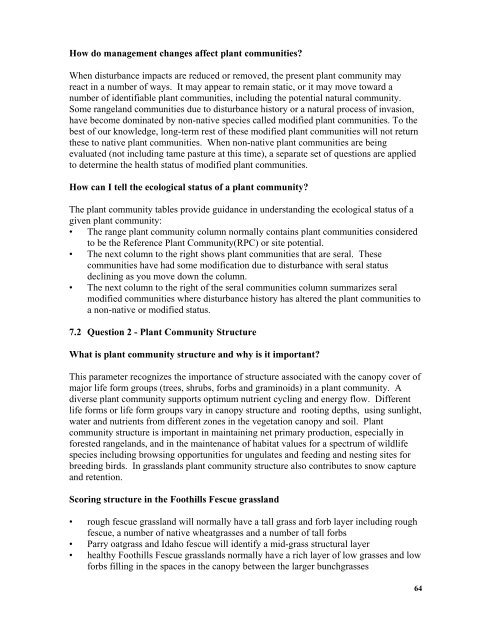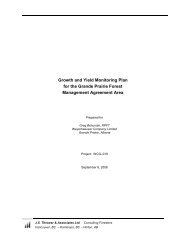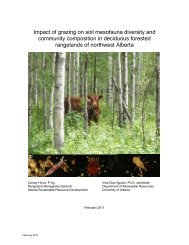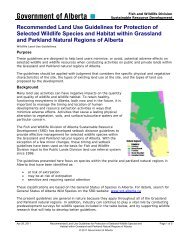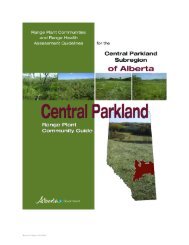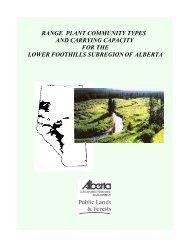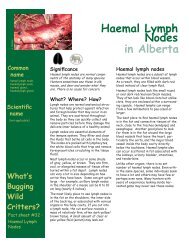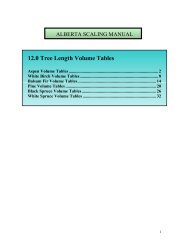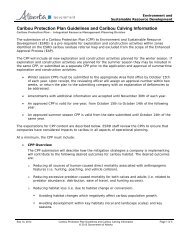Foothills Fescue Range Plant Community Guide - Sustainable ...
Foothills Fescue Range Plant Community Guide - Sustainable ...
Foothills Fescue Range Plant Community Guide - Sustainable ...
Create successful ePaper yourself
Turn your PDF publications into a flip-book with our unique Google optimized e-Paper software.
How do management changes affect plant communities?<br />
When disturbance impacts are reduced or removed, the present plant community may<br />
react in a number of ways. It may appear to remain static, or it may move toward a<br />
number of identifiable plant communities, including the potential natural community.<br />
Some rangeland communities due to disturbance history or a natural process of invasion,<br />
have become dominated by non-native species called modified plant communities. To the<br />
best of our knowledge, long-term rest of these modified plant communities will not return<br />
these to native plant communities. When non-native plant communities are being<br />
evaluated (not including tame pasture at this time), a separate set of questions are applied<br />
to determine the health status of modified plant communities.<br />
How can I tell the ecological status of a plant community?<br />
The plant community tables provide guidance in understanding the ecological status of a<br />
given plant community:<br />
• The range plant community column normally contains plant communities considered<br />
to be the Reference <strong>Plant</strong> <strong>Community</strong>(RPC) or site potential.<br />
• The next column to the right shows plant communities that are seral. These<br />
communities have had some modification due to disturbance with seral status<br />
declining as you move down the column.<br />
• The next column to the right of the seral communities column summarizes seral<br />
modified communities where disturbance history has altered the plant communities to<br />
a non-native or modified status.<br />
7.2 Question 2 - <strong>Plant</strong> <strong>Community</strong> Structure<br />
What is plant community structure and why is it important?<br />
This parameter recognizes the importance of structure associated with the canopy cover of<br />
major life form groups (trees, shrubs, forbs and graminoids) in a plant community. A<br />
diverse plant community supports optimum nutrient cycling and energy flow. Different<br />
life forms or life form groups vary in canopy structure and rooting depths, using sunlight,<br />
water and nutrients from different zones in the vegetation canopy and soil. <strong>Plant</strong><br />
community structure is important in maintaining net primary production, especially in<br />
forested rangelands, and in the maintenance of habitat values for a spectrum of wildlife<br />
species including browsing opportunities for ungulates and feeding and nesting sites for<br />
breeding birds. In grasslands plant community structure also contributes to snow capture<br />
and retention.<br />
Scoring structure in the <strong>Foothills</strong> <strong>Fescue</strong> grassland<br />
• rough fescue grassland will normally have a tall grass and forb layer including rough<br />
fescue, a number of native wheatgrasses and a number of tall forbs<br />
• Parry oatgrass and Idaho fescue will identify a mid-grass structural layer<br />
• healthy <strong>Foothills</strong> <strong>Fescue</strong> grasslands normally have a rich layer of low grasses and low<br />
forbs filling in the spaces in the canopy between the larger bunchgrasses<br />
64


